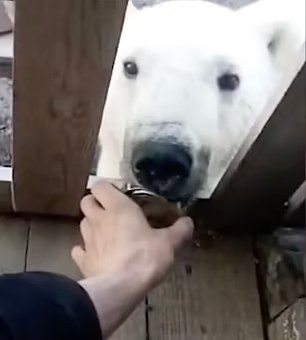A desperate polar bear in northern Russia approached humans for help — a rare and emotional moment in wild nature. The young female animal, unable to eat or drink, had her tongue trapped inside a sharp-edged tin can.
The Discovery in Dikson, Arctic Russia
Residents of Dikson, one of the world’s most northerly settlements, were shocked when a starving polar bear walked into their village. The animal looked weak and dehydrated, its hind legs shaking from exhaustion.
The cause was soon clear — its tongue was jammed deep into an empty can of condensed milk. Locals filmed the heartbreaking scene as the polar bear approached homes and even climbed steps to a porch, clearly seeking human assistance.
Experts later confirmed that polar bears rarely come near people unless driven by extreme hunger.

Locals’ First Attempt to Help
A resident bravely tried to pull the can off the bear’s mouth but could not remove it. The can’s edges were too sharp, and the bear’s tongue was deeply wedged. Any further struggle risked serious injury.
People offered help from a distance, but the wild animal’s stress and strength made a full rescue impossible without sedation. The situation quickly drew attention from wildlife authorities in Russia.
Related read: Full Story: Man Loses 360 Pounds Naturally – Internet Rallies to Support His Next Step
The Emergency Rescue Mission
A veterinary rescue team traveled over 2,100 miles through harsh Arctic weather to reach Dikson. The mission included specialists from the Moscow Zoo and Russia’s environmental watchdog.
After locating the bear about two miles from the local airport, they successfully sedated her with a single dart. Once asleep, the vets carefully removed the tin can and treated several cuts on her tongue caused by the metal.
According to officials, the young female weighed around 85 kilograms and was undernourished but strong enough to recover.

Treatment and Recovery Plan
After the can was removed, the vets cleaned her wounds and ensured no infection would develop. The team then fed her 50 kilograms of fresh fish to restore strength.
Svetlana Radionova, head of Russia’s environmental agency, confirmed that the bear would be monitored for several days before being released back into her natural Arctic habitat — far from human settlements.
Svetlana Akulova, director of the Moscow Zoo, said, “We prepared food and a safe environment for the bear to regain her strength before returning to the wild.”
Why Polar Bears Scavenge Near Humans
As Arctic ice melts and hunting grounds shrink, polar bears are forced closer to human areas in search of food. Garbage dumps and fishing posts can attract them with leftover cans, wrappers, or animal waste.
Experts warn that human litter poses deadly risks. A single can or piece of plastic can cause suffocation or starvation if swallowed or stuck.
This case highlights how pollution endangers even top predators in nature. It also shows how quick, coordinated human response can save lives.

The Science of Polar Bear Behavior
Polar bears usually avoid human contact. They rely on seals for nutrition and can detect prey under thick ice using scent alone. When food becomes scarce, they scavenge — and this is where danger begins.
The Dikson incident is an example of survival instinct overriding fear. The bear’s approach toward people was an act of desperation, not aggression.
Veterinarians say that such behavior signals worsening food scarcity in the Arctic ecosystem.
Further reading: Full Story: Science Confirms Kelly Brook’s Perfect Body – But the Real Message Is Bigger Than Beauty
What Happens Next
The plan is to relocate the recovered bear far from human settlements and continue observation by drone and GPS tag. This ensures she can hunt naturally without returning to towns.
Officials also plan to expand waste control in Arctic regions to prevent similar incidents. Local communities are being urged to secure trash and avoid leaving metal containers accessible.
Lessons from the Rescue
-
Wildlife awareness saves lives. Quick reports from locals helped bring expert aid.
-
Human waste impacts the Arctic. Even a small piece of trash can threaten an entire animal species.
-
Collaboration works. Vets, officials, and citizens cooperated under severe conditions.
-
Compassion matters. The bear trusted humans enough to seek help — a rare sign of intelligence and desperation.
Conclusion
The story of this starving polar bear with a tin can on her tongue is both heartbreaking and hopeful. It shows how nature and humanity can intersect — through tragedy and empathy — to protect endangered life.
As Arctic conditions grow harsher, coexistence requires responsibility. Proper waste management, respect for wildlife, and swift rescue responses are essential to ensure such powerful animals survive for generations.


